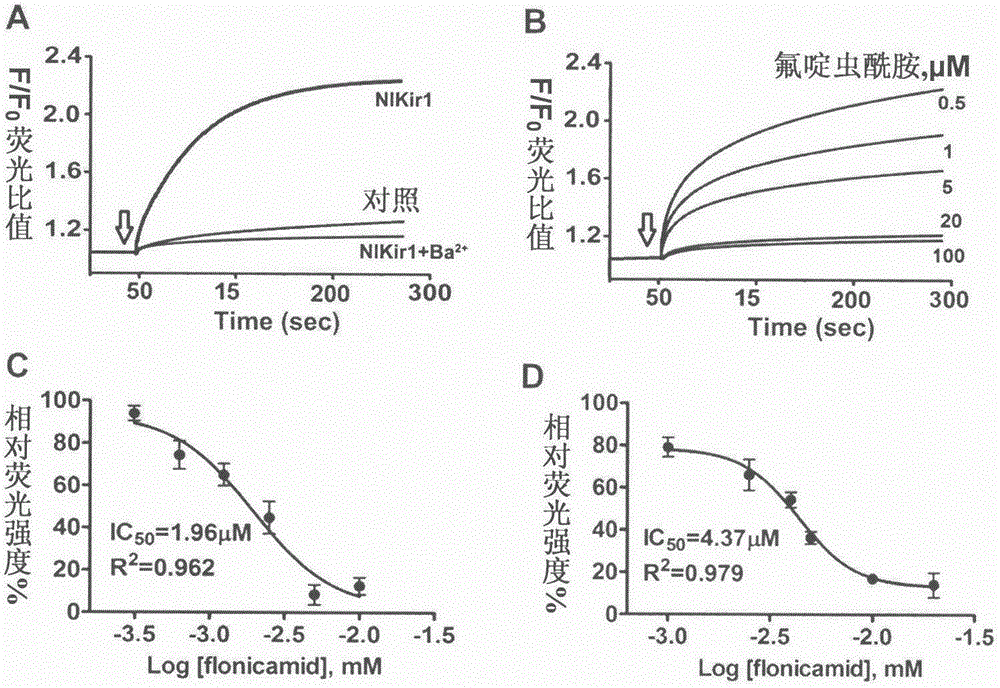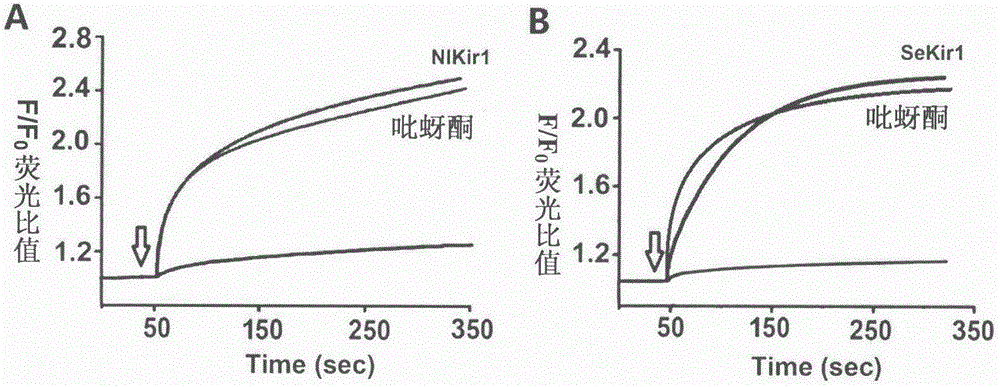High-throughput insecticide screening method for targeting insect Kir1 channel and application of high-throughput insecticide screening method
A screening method and high-throughput technology, applied in the fields of application, botany equipment and methods, biochemical equipment and methods, etc., can solve few problems and achieve the effects of fast detection speed, high specificity and reliability
- Summary
- Abstract
- Description
- Claims
- Application Information
AI Technical Summary
Problems solved by technology
Method used
Image
Examples
Embodiment 1
[0029] Example 1: Cloning of the inward rectifier potassium channel gene Kir1 in brown planthopper and beet armyworm
[0030] RNA extraction kits were used to extract total RNA from N. lugens and Spodoptera lugens, and cDNA was obtained by reverse transcription. Using the cDNA as a template, specific primers (SEQ ID NO.1: 5'-ATGGAAGCGGCCACCAGA-3 ', SEQ ID NO.2:5'-CTAAACCAGGCTCGTATTG-3') and the specific primer (SEQ ID NO.3:5'-ATGTCAGGATTAAAAAGATGTAT-3', SEQ ID NO.4:5'-TCACTTTTCTCATTTACTGTGCTC -3') for PCR amplification, the reaction system includes 12.5 μL 2×Taq Mix, 1 μL each of the upstream and downstream primers, add sterilized ultrapure water to a total volume of 25 μL; the amplification program is: 94°C pre-denaturation for 3 minutes, 94°C denaturation 30s, renaturation at 55°C for 30s, extension at 72°C for 2min, after 30 cycles, total extension at 72°C for 10min. After recovery, the PCR product was ligated with the pMD-19T vector, and the ligated product was transforme...
Embodiment 2
[0031] Example 2: Construction of Kir1 expression plasmid
[0032] The expression vector pcDNA3 was amplified to prepare its plasmid, and the pcDNA3 plasmid was double-digested with restriction endonucleases (Apal and Kpnl) to obtain a linear pcDNA3 vector. The Kir1 sequences with Apal and Kpnl restriction sites at both ends were connected into the pcDNA3 vector, and then transformed into Escherichia coli, positive clones were selected, and the resulting pcDNA3-NlKir1 and pcDNA3-SeKir1 expression plasmids were sequenced and verified.
Embodiment 3
[0033] Example three: transfected cells
[0034] The pcDNA3-NlKir1 and pcDNA3-SeKir1 plasmids were transfected into HEK293 cells. Before the transfection test, HEK293 cells in the logarithmic growth phase were digested with trypsin, inoculated in a 24-well culture plate, added complete medium and placed in a CO2 incubator. When the cells grew to 60-80%, take Opti -MEM Medium Wash the cells and replace the complete medium in the dish. The configuration of the transfection mixture: Take three 1.5mL EP tubes and add 200 μL of Opti-MEM medium and 1-2 μg of purified pEGFP-N1-SeKir1, pEGFP-N1-NlKir1, pEGFP-N1 (blank vector) plasmids, Take another 3 1.5mL EP tubes, add 200 μL of Opti-MEM medium and 2 μL of Lipofectin 2000 reagent, let it stand for about 5 minutes, gently mix the Opti-MEM medium containing the carrier and transfection reagent to form liposome-DNA complexes After standing at room temperature for 5-30 minutes, slowly add the liposome-DNA mixture to the culture plate, ...
PUM
 Login to View More
Login to View More Abstract
Description
Claims
Application Information
 Login to View More
Login to View More - R&D
- Intellectual Property
- Life Sciences
- Materials
- Tech Scout
- Unparalleled Data Quality
- Higher Quality Content
- 60% Fewer Hallucinations
Browse by: Latest US Patents, China's latest patents, Technical Efficacy Thesaurus, Application Domain, Technology Topic, Popular Technical Reports.
© 2025 PatSnap. All rights reserved.Legal|Privacy policy|Modern Slavery Act Transparency Statement|Sitemap|About US| Contact US: help@patsnap.com



